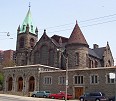St. Peter’s is located at 188 Carlton Street near Sherbourne in downtown Toronto. The historical plaque on the building reads: “This parish, which extends from Yonge Street to the Don River, was established in 1863, using the chapel in St. James’ Cemetery for worship. (see page 2 of churches for a profile of this chapel) The following year Gundry & Langley designed this church in High Victorian Gothic style. It was opened by John Strachan, Bishop of Toronto, on 10 June 1866. Additions were made in 1872 and 1880 to accommodate the growing congregation and the original south entrance became a baptistry. Following a serious fire in 1973, the chancel was modified and a choir and organ gallery built in the west end.”
St. Lukes is located on Sherbourne Street at Carlton, just across from St. Peter’s Anglican, profiled above. In 1987 a historical plaque was erected to commemorate the church’s centennial, which reads: “This church was known as Sherbourne Street Methodist when it opened for worship 5 June 1887. Designed by architects Langley & Burke, it replaced a smaller house of worship built here in 1871. The handsome stonework and fine stained glass are of special note. Memorial windows bear the names of Sir Joseph Flavelle, Sir Albert Kemp, H.H. Fudger and Richard Brown, who along with many other prominent Toronto businessmen were active members of the congregation. Their philanthropy and participation in social programs began a community-minded tradition that has continued through the years. In 1959 Sherbourne and Carlton United joined to form Saint Luke’s United Church.”
This church is located at the northeast corner of Jarvis and Gerrard Streets. The historical plaque on the building reads: “The congregation of this church was formally organized in 1829, with chapels on Lombard Street (1832) and Bond Street (1848). Growing membership necessitated a new building, and this Gothic Revival church, designed by Edmund Burke, was begun in May, 1874. Built of Queenston stone, it was one of the first in Canada to use a u-shaped galleried auditorium. The Jarvis Street Baptist Church was dedicated in December, 1875, and has maintained an active ministry in this area.”
Located at Bond and Shuter Streets in downtown Toronto, the historic plaque reads: “The cornerstone of St. Michael’s Cathedral was laid on May 8, 1845, by the Most Reverend Michael Power, first Catholic Bishop of Toronto. Designed by William Thomas, the building is an adaptation of the 14th century English Gothic style. It was consecrated on September 29, 1848. Though the transepts remain unfinished, St. Michael’s adheres to the ancient cruciform shape of religious structures. The interior of the great chancel window, installed in 1858, was executed by Etienne Thevenot, a gifted French artist and was donated by Bishop de Charbonnel. Construction of the tower and spire began in 1867. St. Michael’s is the principal church of Canada’s largest English-speaking Catholic archdiocese.”
Located at Queen and Church Streets, the historic plaque reads: “This “Cathedral of Methodism” was designed by Henry Langley in the High Victorian Gothic style. The cornerstone was laid by the Rev. Egerton Ryerson, C.C., in 1870 and the church was dedicated in 1872. It replaced an earlier structure at the southeast corner of Adelaide and Toronto Streets. The first missionaries from Canada to Japan were commissioned in this church on May 7, 1873. The inaugural service of the Methodist Church of Canada was held here September 16, 1874. The World Ecumenical Methodist Conference meetings in 1911 and the first General Council of the United Church in 1925 met here. The church was badly damaged by fire in 1928 and rebuilt, incorporating most of the original walls, tower, narthex, and much of the stained glass.”



